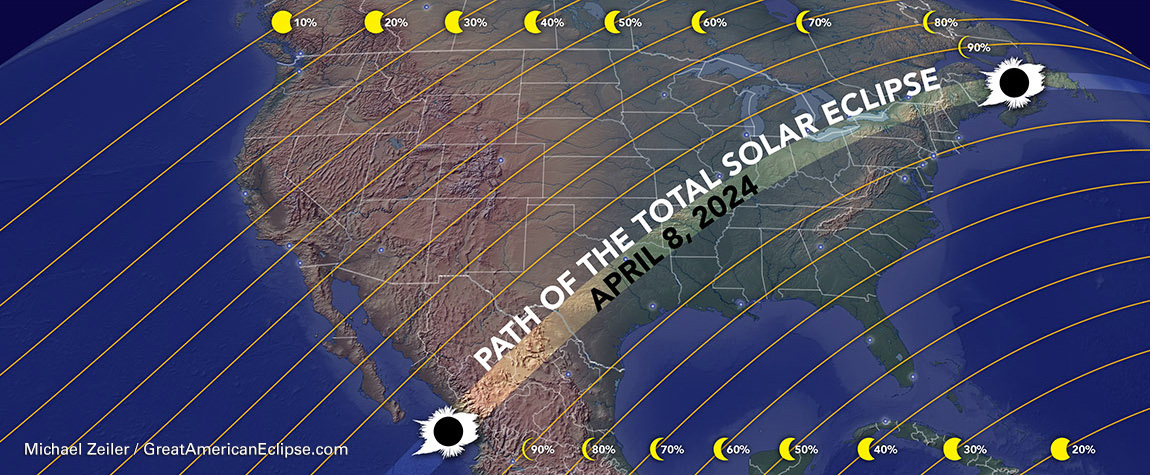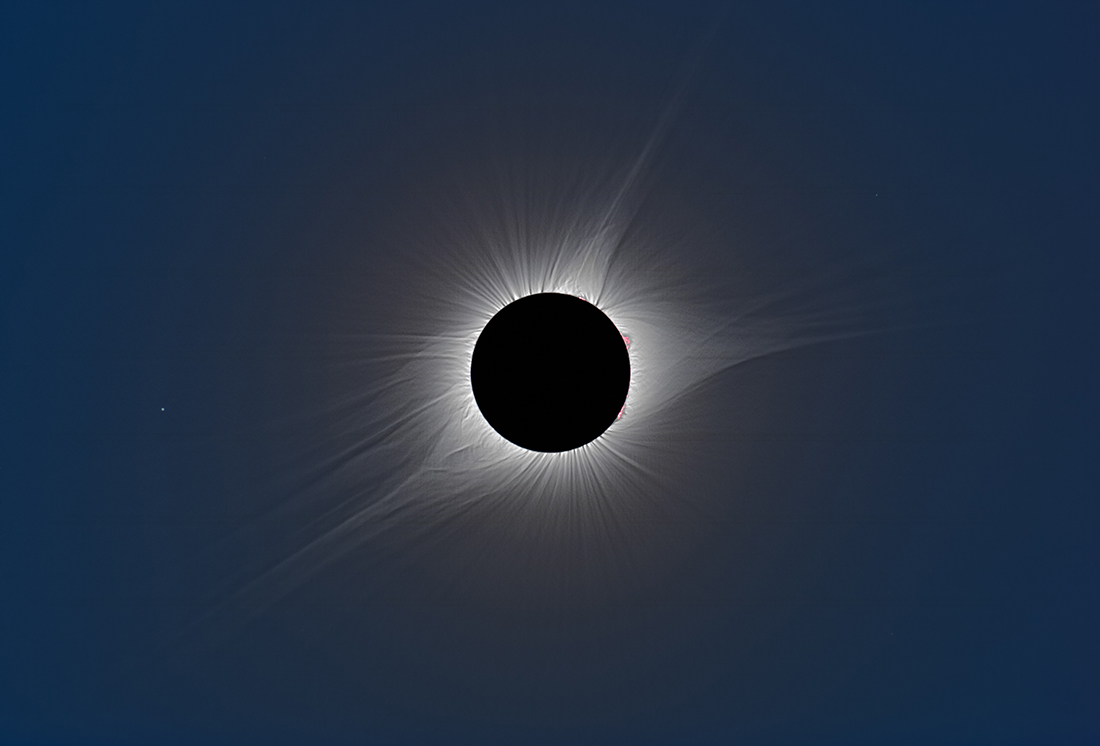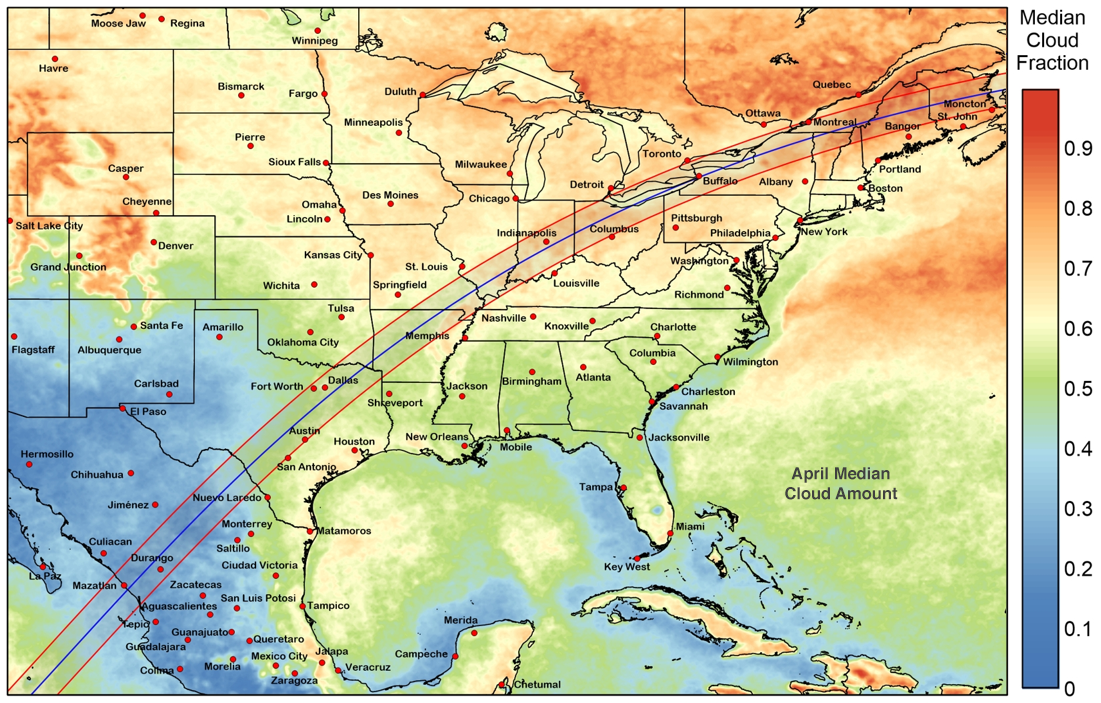
Monday, April 8, 2024: Mark Your Calendar!
Do you remember the total solar eclipse that crossed the continental United States from coast to coast on August 21, 2017? If you lived in, or traveled into, the 70-mile-wide path of totality, where the Moon completely blocked the Sun and turned day into night for 2 minutes or so, you undoubtedly remember it well. If you were outside that path under clear skies somewhere else in North America (or northern South America), perhaps you saw a partial solar eclipse that day.

The 2017 total solar eclipse was the first to touch the "Lower 48" since 1979 and the first to span the U.S. from coast to coast since 1918. Remarkably, another total solar eclipse is coming to North America on April 8, 2024, just seven years after the last one. This time the Moon's dark central shadow, about 115 miles wide, will cross Mexico, sweep northeast from Texas to Maine, and then darken parts of Eastern Canada. A partial solar eclipse will be visible to nearly everyone in North America fortunate to have cloud-free skies.
During a total solar eclipse, the Moon blocks the Sun’s bright face — the photosphere — briefly revealing our star’s outer atmosphere: the shimmering corona, or “crown.” Made of rarefied gas heated to millions of degrees, with its atoms highly ionized (stripped of electrons), the diaphanous corona gets sculpted into streamers and loops by the Sun’s powerful magnetic field and shines with a light seen nowhere else. It is hauntingly beautiful and, without doubt, one of the most awesome sights in all of nature.
The corona is always there, but we usually can’t see it because the photosphere is about a million times brighter and drowns it out. When the Moon covers the Sun's bright face, the corona is definitely the main attraction, but there’s so much more to the experience. At the beginning and end of totality, the thin middle layer of the Sun’s atmosphere, the chromosphere, blazes in an arc of ruby red. The sky darkens to a deep twilight blue, with yellow, orange, and pink sunrise/sunset colors on the horizon in all directions. Bright stars and planets shine forth, and the air temperature drops noticeably. Birds and farm animals, thinking dusk has settled, return to their nests and barns, and bats come out to feed.
Get Yourself into the Path of Totality!
Outside the path of totality nearly all of North America will get a partial solar eclipse. But even a 99% partial eclipse pales in comparison to a total one. If you didn't know a partial eclipse was happening, you might overlook it, as it gets no darker than on a cloudy day. Within the path, though, as the Moon covers the last 1% of the Sun's bright face in less than a minute's time, the daylight fades by a factor of up to 1,000! If you weren't expecting that, you might think the world was coming to an end!
With the path stretching from Mexico to Canada, where should you plan to rendezvous with the Moon's shadow? Most eclipse aficionados go where the weather prospects are most favorable. For this eclipse, as shown in the graphic below, that's Mexico or southern Texas. But anywhere within the path beats everywhere outside it, so if you can't travel to Mexico or Texas, try to get into the path wherever you can — you won't regret it!

Depending on your location within the path of totality, the corona will be visible for up to 4 minutes 28 seconds. During those precious moments, it is perfectly safe to look directly at the Sun, even through binoculars or a telescope. But whenever any part of the photosphere is uncovered, it is essential to view the Sun through a safe solar filter, that is, one that meets the transmission requirements of the ISO 12312-2 international standard. Such filters are widely available and cost at most a few dollars. Looking at the uneclipsed or partially eclipsed Sun through dark sunglasses or any other unapproved filter is a recipe for serious and potentially permanent eye injury. See our Eye Safety and Resources pages for details.

More Information About the Solar Eclipse of April 8, 2024
- Eclipse2024.org (Dan McGlaun)
- EclipseWise.com (Fred Espenak)
- Eclipsophile.com (Jay Anderson)
- GreatAmericanEclipse.com (Michael Zeiler)
- Interactive Google Map (Xavier Jubier)
- NASA Science
- NationalEclipse.com
- Shadow & Substance (Larry Koehn)
- Sky & Telescope's Online Eclipse Portal
- Texas Nexus (Patricia Reiff, Rice University)
- TimeandDate.com
- How & Why Solar Eclipses Happen
- How Dark Does It Get During a Total Solar Eclipse?
- How to View a Solar Eclipse Safely
- The Solar Eclipse Experience

